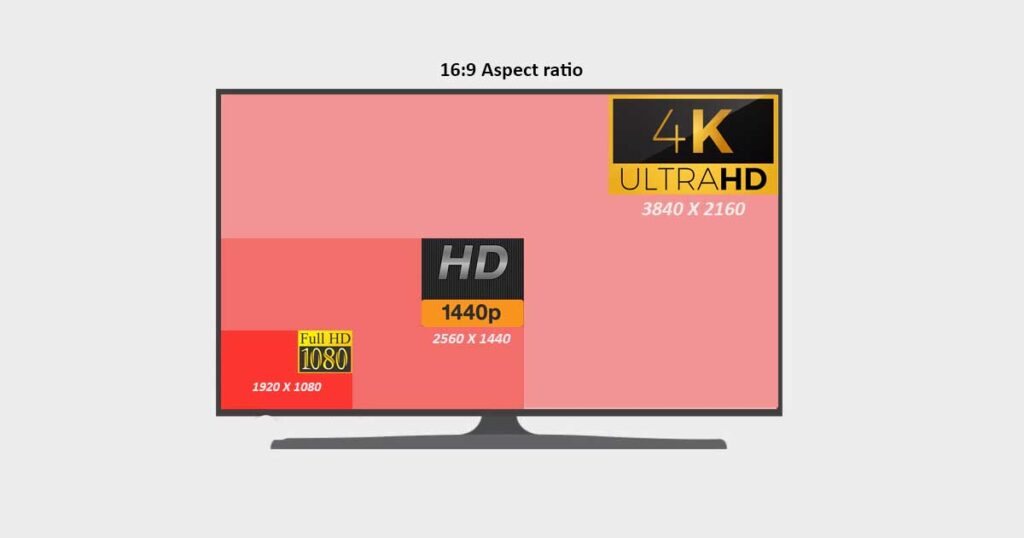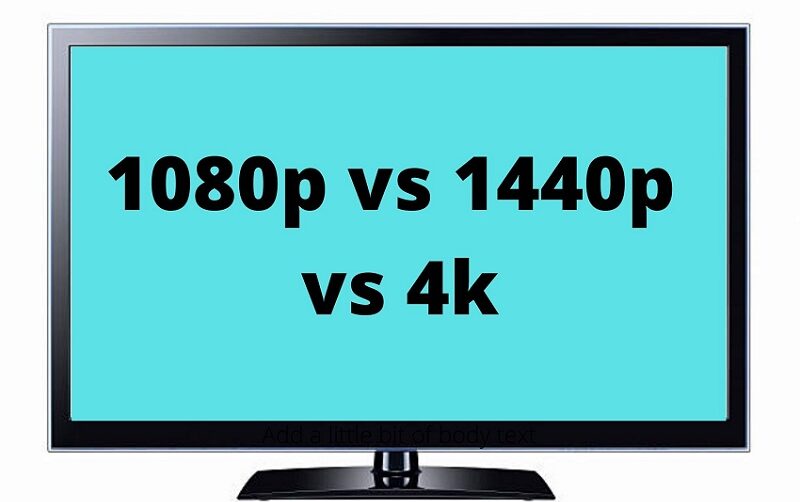Resolution is the measure of the number of pixels on a given display. This gives you figures such as 1080p, 1440p, 4K, and so on.
A 1080p display (1920 by 1080) has 2,073,600 pixels, a 1440p display (2560 by 1440) has 3,686,400 pixels and a 4K display (3840 by 2160) has 8,294,400 pixels. This is a 44% pixel count difference between 1080p and 1440p, a 4x difference between 1080p and 4k, and a 2.25x difference between 1440p and 4K.
With each increase in the number of pixels, the clarity, and detail level increases depending on the screen size and aspect ratio. You will only have a noticeable difference when using a bigger display.
Although you should not base your buying decisions based on resolution alone, it’s essential to understand their differences by reading this comparison guide.
1080p, 1440p & 4k- An overview
1080p
In 1080p resolution or 1920 by 1080 pixels, the 1080 height pixels are used to represent this resolution on a display with an aspect ratio of 16:9.
This resolution is also known as Full HD, FHD, or Full High Definition and is most commonly found on TVs, projectors, and computer monitors.
Full HD displays have double pixel count as 720p devices. 1080p is now considered the standard HD resolution. Unless you are on a limited budget, getting a 1080p monitor, projector, or TV may not be the best idea as display tech rapidly improves.
1440p
1440p or 2560 by 1440 pixels is also known as QHD, Quad High Definition, or WQHD.
This resolution is mainly found on computer monitors and laptop screens and is considered the sweet spot between 1080p and 4k. 1440p is mostly used for pc gaming but can also be found in gaming consoles such as the Xbox One S and PS4 pro.
If your budget is limited for a high-quality 4K monitor, a 1440p monitor or laptop should be your next logical alternative.
4K resolution
Usually, 4K is used to represent 3840 by 2160 pixels (UHD/Ultra High definition) and is the most common 4K resolution on displays found in today’s market. However, it can also be used on displays with 4096 by 2160 resolution (True 4K/Cinema 4K) and is 256 pixels wider which adds up to a 13% difference.
UHD can be found on TVs, projectors, monitors, and laptops while True 4K is mainly found on projectors, especially those used in cinemas.
Now would be a great time to make a switch to 4K as it has become increasingly popular with more content being released in 4K. The release of the PS5 and Xbox X consoles capable of up to 8K have popularized 4K gaming.

1080p/1440p vs 1080i/1440i
The difference between 1080p and 1080i or 1440p and 1440i is the “P” which stands for progressive and the “I” for interlaced. Both of them have the same resolution but it comes down to how the image is displayed.
On an interlaced display, the images are displayed by rapidly switching back and forth between odd and even pixels while progressive displays scan and draw each pixel multiple times a second.
Progressive displays produce more stable and higher-quality images when compared to interlaced displays that are prone to flickering.
How to choose
There are several things such as budget and viewing habits you should consider when choosing a display device. Don’t base your buying decisions on resolution alone.
Although each resolution has its benefits and drawbacks, a higher pixel count doesn’t always mean better. With an increase in resolution, more power is drawn by the display to create images at the same frame rate.
But here is what to consider before making a purchase;
1. Screen size and pixel density
Having more pixels on a display will not make a huge difference if the screen is small. Screen size affects pixel density, PPI (pixel per inch), or DPI (dots per inch).
An example of this would be a 27” 1440p monitor with a pixel density of 108 which when compared to a similar-sized 1080p monitor with a PPI of 81, will be clearer and more detailed.
With a 27-inch 4K monitor, the PPI is 163 which is more detailed but can be overkill at this viewing distance and screen size. This is due to our eye limitations. To take advantage of a 4K resolution, a larger monitor will give you a better experience.
Real estate is another important consideration at different screen sizes. The higher the resolution, the more space you will have to work with on a monitor.
When comparing our 27-inch 4K monitor to a similar-sized 1080p monitor, the 4K display will have 4 times the space to work with. Multitasking will be much easier as you can fit more windows in the space.
However, the downside is that at 27 inches, more real estate will diminish the value size of your content and can make text virtually unreadable at some points. You can scale your values for better readability in your display settings.
It’s important to strike a balance between resolution and screen size, especially for monitors and TVs.
2. Refresh rate
Refresh rate denoted as Hz (hertz) is the number of times an image is regenerated on screen per second. For example, with a 144Hz refresh rate, the image is regenerated 144 times a second.
When combined with a proper resolution, a higher refresh rate will give you a smoother experience, especially as a gamer.
Although the refreshing happens so fast at all refresh rates, our eyes are good at picking up significant jumps in refresh rates (eg 60 to 120 Hz), especially for high FPS games such as Rocket League.
So how does refresh rate affect resolution?
Increasing resolution tends to lower refresh rates. This means that you can find a reasonably priced 1440p display with a higher refresh rate such as 144Hz but a costlier 4K display with a refresh rate of 60Hz at 4K.
Using a UHD monitor with a low refresh rate will not be great if you are experiencing stutter causing you to miss shots. You would rather get a 1440p monitor at 144Hz.
However, it also comes down to what you use the display for. For example, for movies, a higher resolution will be better than a high refresh rate since movies are usually made at 24 or 30 FPS (frames per second).
3. Display device use
Whether you are a competitive eSport gamer, a graphic/motion designer, or a movie buff, you will need a display with a resolution and refresh rate tailored to your needs.
To a non-competitive gamer that mainly plays games such as Rise of the Tomb Raider for fun, a 4K monitor will be more important than a 240Hz refresh rate. Here the visuals and color accuracy will matter more than the refresh rate. The same applies to a movie lover or a graphic designer.
However, for a competitive gamer where each microsecond matters, a 240Hz monitor at 1440p will be better than 60 Hz at 4K.
4. Your Budget (cost)
Budget is the biggest determinant when it comes to choosing between 1080p, 1440p, or 4K displays.
Balancing cost with value is crucial while trying to keep up with display tech. You will not only need to look at the resolution and refresh rate but other features such as build quality. However, it is important to note that higher-resolution displays have gotten increasingly affordable.
With that said, I would recommend getting a display with a 4K resolution, especially for TVs or projectors, and at least 1440p for a monitor if you are within budget (all factors considered).
For a monitor with a higher resolution (4k), a more powerful graphics card, CPU, and power supply unit will be required increasing the overall cost.
Which is better?
Depending on what you plan to do, your personal preference, and most importantly your budget, ensuring that you get the right display for your needs will be of utmost importance.
Not one resolution can be a fit-all for everyone, but there are different products with varying qualities to meet your needs. Using this guide as a start, you can start your journey in search of the “perfect display” for you.


